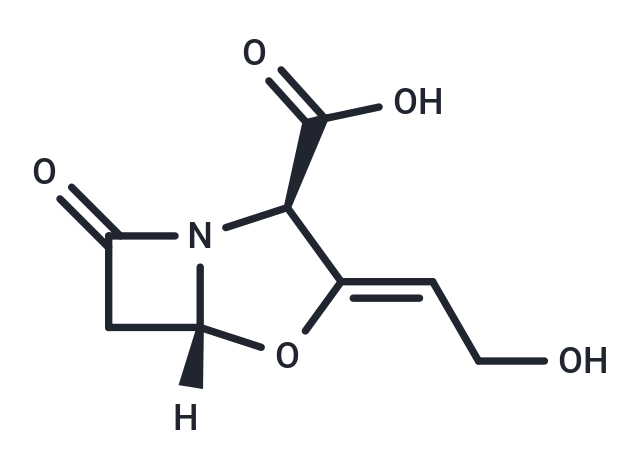Shopping Cart
- Remove All
 Your shopping cart is currently empty
Your shopping cart is currently empty

Clavulanic Acid(RX-10100), a major beta-lactam antibiotic produced by the organism Streptomyces claveris, is a potent bacterial beta-lactamase inhibitor used in the study of infections caused by bacteria. Clavulanic Acid has a broad spectrum of biological activity and is active against a wide variety of Gram-positive and Gram-negative bacteria.

| Pack Size | Price | Availability | Quantity |
|---|---|---|---|
| 10 mg | $39 | In Stock | |
| 25 mg | $55 | In Stock | |
| 50 mg | Inquiry | In Stock |
| Description | Clavulanic Acid(RX-10100), a major beta-lactam antibiotic produced by the organism Streptomyces claveris, is a potent bacterial beta-lactamase inhibitor used in the study of infections caused by bacteria. Clavulanic Acid has a broad spectrum of biological activity and is active against a wide variety of Gram-positive and Gram-negative bacteria. |
| In vitro | Clavulanic acid exhibits synergistic antibacterial activity with ampicillin against microorganisms producing β-lactamase[2]. Clavulanic acid inhibits strains Ab11 and Ab51 with a minimum inhibitory concentration (MIC) ranging from 2 to 8 μg/mL[4]. |
| In vivo | In C57BL/6 mice with Pseudomonas aeruginosa pneumonia, intraperitoneal injection of clavulanic acid (13 mg/kg) reduces bacterial burden in the lungs[4]. In C57BL/6 mice infected with Ab51, intraperitoneal injection of clavulanic acid (13 mg/kg) shows a half-life (t1/2) of 6.69 hours and an area under the curve (AUC) of 4.03 mg·h/L in a lung infection model[4]. In a rat model of carrageenan-induced paw edema, intraperitoneal injection of clavulanic acid (100-300 mg/kg) exhibits anti-inflammatory effects[3]. |
| Alias | RX-10100, MM-14151, MM14151, MM 14151, BRL-14151, BRL14151, BRL 14151 |
| Molecular Weight | 199.16 |
| Formula | C8H9NO5 |
| Cas No. | 58001-44-8 |
| Smiles | [H][C@@]12CC(=O)N1[C@@H](C(O)=O)\C(O2)=C\CO |
| Relative Density. | 1.65 g/cm3 |
| Storage | store at low temperature,store under nitrogen | Powder: -20°C for 3 years | In solvent: -80°C for 1 year | Shipping with blue ice/Shipping at ambient temperature. | ||||||||||||||||||||||||||||||
| Solubility Information | DMSO: 10 mg/mL (50.21 mM), Sonication is recommended. | ||||||||||||||||||||||||||||||
Solution Preparation Table | |||||||||||||||||||||||||||||||
DMSO
| |||||||||||||||||||||||||||||||

Copyright © 2015-2025 TargetMol Chemicals Inc. All Rights Reserved.